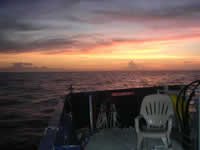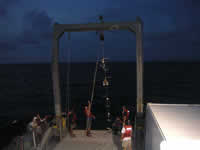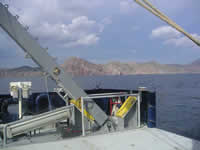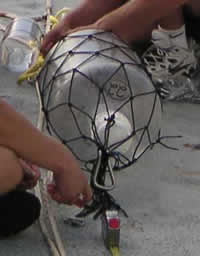


|
The Project Part 1: Part 2: Part 3:
|
30 July, 2005
|
 Sunset over the Gulf  Pulling in the array early in the morning  The coast of Isla Tiburón |
As promised, here is the origin of the word “carboy.”
The word “carboy” comes to us from a Persian word (qar ba), which was derived from an Arabic word (qarr bah). Qar ba describes a particular kind of bottle with a 5 to 15 gallon capacity and which usually is encased in some sort of protective cover. It sounds like an appropriate word for what the scientists are using, don’t you think?
More from The Log from the Sea of Cortez
It would be ridiculous to suggest that ours was anything but a makeshift expedition. We had onboard no permanent laboratory. There was plenty of room for one in the fish hold, but the permanent dampness there would have rusted the instruments overnight. We had no darkroom, no permanent aquaria, no tanks for keeping animals alive, no pumps for delivering seawater. We had not even a desk except the galley table.
This is where the similarity between Steinbeck and Ricketts’ trip and that of the R/V New Horizon ends. This expedition has been in the making for a couple of years. We boarded the ship with a detailed plan of action. Boxes and boxes of lab equipment, chemical solutions, maybe 18 lap tops, and several desk top computers carry out the work of the cruise. The ship is loaded with navigation electronics, depth sensors, winches, cables, and four dedicated laboratory spaces onboard. We have updated modern staterooms, showers, air conditioning, and a fresh water maker that distills salt water. It would be ridiculous to suggest that ours wasn’t anything but a very well planned expedition.
Today at 5 am we pulled the array with the carboys from the water. After that we left for the northern part of the Gulf of California, a trip of about 21 hours. Everyone is tired from the night work we’ve been doing, and we are looking forward to a little downtime. This afternoon we have a safety drill and later we will pass close to Isla Tiburón (Shark Island), the largest island in the Gulf of California. Across from Tiburón is Isla San Esteban. Tiburón holds a Mexican navy base, but the island belongs to the Seri, a native people. Eduardo, the Mexican oceanographer who boarded the ship in Guaymas, has done research there. He had to obtain permission from a governing council of the Seri in order to work there. The Seri are a matriarchal people in some respects. This means that women rule the roost, boys. The Seri have lived here for thousands of years; warfare with other ethnic groups and the arrival of the Europeans reduced their territory and influence. They are fisher people living in an arid and harsh landscape. The Seri are famous for woodcarving, and use a hard wood called “palo fiero,” or “hard stick,” in Spanish. The Seri still speak their native language, Comcáac, but also understand and use Spanish.
This afternoon and evening we have seen many dolphins, some swimming right next to the ship. In the distance we saw more of them breaking the surface. There are many sea birds flying past us, too. And right at sunset, a pod of whales swam past; we think they might have been orcas, or killer whales.
Math Problem:
Isla Tiburón is about 80 kilometers long by 40 kilometers wide. What is the area of the island in kilometers? What is the area of the island in square miles?
Trivia Tidbit of the Day:
In 1903, President Theodore Roosevelt established the first national wildlife refuge--Pelican Island, in Florida--to protect the nesting sites of brown pelicans.
![]()

